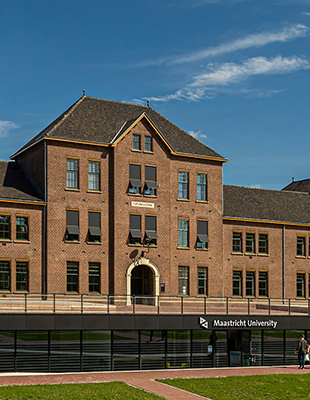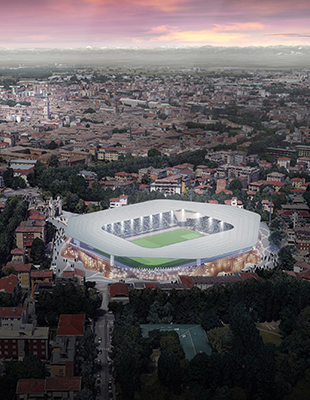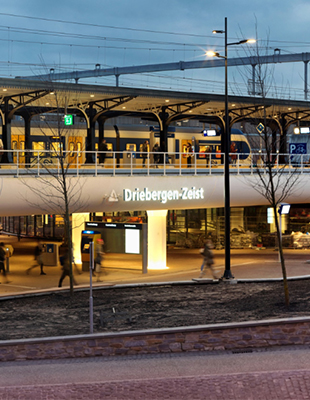Table of Contents
The challenge
Transforming a former military barracks into a healthy and productive modern learning and research space for staff and students at Maastricht University.
1,000
Maastricht University in the Netherlands is a popular destination for students and scientists looking to progress their academic careers. The university has been growing for many years and now has more than 21,000 students and almost 5,000 staff members. To meet future demand, the university needed to expand its estate.
Acquiring the Tapijnkazerne – a neighboring former army barracks – there was scope to provide much needed capacity for an additional 1,000 students and 20 staff, but the site’s aged design and accommodation were not consistent with the university’s strategy for sustainability, or their aspirations for the student and staff experience. Furthermore, given the accommodation would house the Faculty of Life Sciences and Health, there was an appetite from the university to push the boundaries and create an exemplar that encapsulated the teaching and research prowess of the faculty. It wanted to demonstrate that it’s not just a case of ‘practice what you preach’, but practice what you ‘teach’.
The solution
Using the WELL Building Standard to design a place that promotes high levels of health and wellbeing, creating optimal conditions for students and academics.
99%
As a leading member and Founding Partner of the Blue Buildings Institute (BBI), Arcadis has been influential in the translation, promotion and delivery of the WELL Building Standard (WELL) in the real estate and construction sectors in The Netherlands.
WELL takes a holistic approach across ten concepts that comprehensively address the design and operations of buildings, and importantly, how they impact and influence human behaviors related to health and wellbeing.
To guide the university in achieving the WELL standard, Arcadis’ WELL-accredited professionals partnered with the design team and contractors supporting the implementation and validation of WELL Building measures.
Given the Tapijnkazerne’s listed status, all measures were designed to be sympathetic to the original design, preserving its heritage elements. For example, when optimizing air quality, rather than replacing the original ventilation, modifications were made to improve it. This saw 'intelligent' controls installed to continuously measure the air quality in the rooms, adjusting the enhanced and highly-filtered supply of fresh air in accordance with the number of people occupying the spaces. This ensured that the supplied air is always 100% fresh – and at higher quality levels than required by Dutch legislation – with no air being recirculated.
-
READ MORE
Light was also a main consideration for WELL, with extensive calculations and daylight simulations drawn up prior to construction, to optimize lighting design. As a result, all indoor lighting is compliant with the highest illuminance recommendations specified within the strict European standard. This means that the lighting can help occupants to maintain a healthy circadian system, with all workspaces receiving optimal levels of light, either through direct daylight exposure or through electric lighting.
To ensure comfort – another core WELL concept – heating, ventilation, and air conditioning (HVAC) systems were designed to focus on ‘thermal comfort’. This ensured people do not feel too hot or too cold. This was achieved through the design of ‘thermal zones’, encompassing heating, cooling, blinds, lighting and ventilation, which can be directly regulated by people using the room, covering 99% of regularly occupied spaces throughout the building.
Sound is another WELL factor, and a number of sound-limiting interventions were made to aid concentration and focus, with oversized fans and ventilation ducts employed. Sound-insulation was added to windows that had listed status and could not be replaced. Sound mapping was used to create acoustic barriers between different user zones, ensuring low background noise levels and an optimized working environment.
99%
53 points

The impact
Creating the first WELL certified university building in Europe, aligned to the university’s own sustainability aspirations and academic research.
53 points
The end result is much greater than the sum of its parts. Not only was Maastricht University able to create an environmentally-friendly and sustainable building to support the education of 1,000 students, but it also became the first university to meet the WELL Building Standard.
It is this focus on human sustainability, performance and productivity that most closely resonates with the Faculty of Life Sciences and Health’s own research agenda, supporting their existing staff and students to be happier, more engaged, more productive and healthier, and hopefully encouraging others to join the university in the future.
Furthermore, Maastricht University will use the knowledge it acquired during the WELL Building process for the Tapijnkazerne within future real estate activities, and it is hoped that the building will serve as a living lab for Health research.
Not done reading?
This also might be interesting for you
- Related Projects
- Related Insights









